- Home
- Various Articles - Approaches
- English as a Medium of Instruction (EMI): Developing Online and F2F Support Strategies at Verona University
English as a Medium of Instruction (EMI): Developing Online and F2F Support Strategies at Verona University
Sharon Hartle is an associate professor in the Department of Foreign Languages and Literatures at Verona University. She is specialized in English Language teaching (ELT) pedagogy and didactics and one of her major interests is English Medium Instruction. She has designed and organised EMI lecturer training courses for several years at Verona University. Email: sharon.hartle@univr.it
Geltrude Daniela Vescio, Mary Birkett and Massimo Marzio teach ELT at the Verona University Language Centre and have been involved in mentoring Lecturers attending EMI courses. The four authors are working together on a research project aimed at analysing lecturer perceptions and the strategies they implement in EMI. Emails: geltrudedaniela.vescio@univr.it, mary.birkett@univr.it, massimo.marzio@univr.it
Abstract
A range of research has been conducted in the English Medium Instruction (EMI) field, ranging from EMI from the point of the learner and the teacher to the role of this content delivery mode as a key component of internationalization in Higher Education institutions. This study, which is ongoing at the University of Verona, analyses the perceptions of lecturers from a range of disciplines with regard to English in their EMI teaching process. Data has been gathered over a period of time during which both a training course and mentoring service were provided to aid lecturers develop an awareness of their needs and of available pedagogical resources that could be used to meet them. What emerged was a shifting of focus from lecturer linguistic competence to a concern for learner needs and what was innovative was the interest in combining traditional classroom practices with digital ones.
Introduction
At Verona University seven complete post-graduate courses are currently taught in English and other courses have partial components taught in a second language (L2). This article focuses on the beliefs and needs of lecturers involved in English Medium Instruction (EMI) at this university, and explores their beliefs. Conducted parallel to a lecturer support course provided by the university for those involved in teaching their own subjects in English, our study shows how these beliefs and focus shifted over the course from a preoccupation with their own language competence to concern for learner support they can provide in their specific context which often involves large university groups of 100 students or more.
Background
Before looking more closely at the study, however it is worth pausing to consider briefly what EMI is. It can be distinguished from other types of content-based learning in that there are no secondary aims. EMI, as defined by Dearden and Macaro (2016), fundamentally entails teaching a subject in English in an area where English is not the native language. Unlike CLIL, there is no intention of improving students’ English and specific structures or lexis are not inserted into lessons in order to present them to students. (Dearden and Macaro Op. cit.). Our lecturers, in fact, are concerned with teaching their own subjects in the most effective way in an L2 rather than improving learner English competence.
The spread of EMI
EMI, as a practice, has spread widely over the past few years in Higher Education (HE) (Dearden 2016) as a response to the driving forces of globalization. Perhaps the most obvious aim of teaching university courses in an L2 is that of attracting students from outside the local or even national population. In this way universities build their global identity, their international student population (Jensen and Thogersen 2011), but perhaps even more importantly, their student numbers in general.
Research seems to show that professional development is mostly concerned with giving support to those using English to teach their subjects (Helm 2019). Perhaps not surprisingly, insecurities about English are mentioned frequently by lecturers themselves as well as students (Airey 2011). This was certainly reflected in our study, as mentioned above, where lecturers were initially concerned almost entirely with matters of their own linguistic competence but then shifted towards an awareness of their learners’ difficulties.
Learner difficulty in studying in an L2 is a key issue, in fact, in the EMI literature where various questions have arisen regarding, in particular, the increased time investment required for students studying university level content in a language which is not their own and this is also true of lecturers, who are required to teach their course in a second language. They are right to be concerned about their own language competence as there seems to be no consensus on what levels of English are necessary for both lecturers and students involved in EMI courses (Macaro et al. 2018). Clearly support is required for all those involved in EMI.
Why choose blended learning?
One means of supporting those studying a complex HE syllabus in an L2 is to deliver content by means of blended learning (BL), but this format is not always familiar to lecturers who need guidance in implementing it. BL, in fact, usually entails the use of digital technology combined with face to face (f2f) teaching (Hartle 2018), enhancing both f2f and autonomous online learning. For instance, lectures can be recorded for future reference for students who can listen again, interactive quizzes allow students to check their understanding (Helm 2019). Content could be accessed by students before the lecture so they can prepare by checking the material in advance. (Hartle Op. cit.). This provides students with more flexibility and support which would not be available if the course content were delivered purely through traditional channels. Our lecturers were aware of the problem which led them to seek appropriate methodologies to support L2 learning in an HE context. In particular, there was a strong interest in how BL could be developed and which technological tools could be used both online and in the f2f classroom. Two main areas that were addressed as a result were firstly classroom management techniques, informed by the work done in the ELT field where teaching in an L2 is often the norm and, secondly, the use of digital tools.
The use of pedagogical technology in teaching and the aim for greater internationalization are, in fact, two innovative trends which have characterized HE in the last two decades even though until now they have not usually been seen as closely linked. Currently, in fact, they are not always considered to be a potential match or even as offering reciprocal added value to each other (De Wit, 2016:69) and as Helm (2019) pointed out, it is surprising and somehow curious to remark that technology in education and the rise of EMI are not more frequently associated. Our own study, as mentioned above, indicates that lecturers are, in fact, keen to implement technological solutions that are appropriate in their own teaching contexts.
Verona University EMI lecturer support
The training course
Verona University provides a 40-hour course with the support of one to-one mentoring sessions. This is provided for lecturers who wish to receive technological and language support for EMI. The course focuses on the two main areas mentioned above, classroom management and the implementation of digital tools in a BL context. Key topics on the course which have grown out of our observation of lecturer needs are: specific language for teaching in an L2 with a focus on areas such as delivering lectures, classroom management, materials development for L2 learners, managing office hours in more informal registers, together with an introduction to BL teaching and how to use technological tools such as PowerPoint, Mentimeter, Socrative, Padlet and Quizlet (see sitology for links)
The mentoring service
Lecturers are also offered three individual mentoring sessions to supplement the course, which are scheduled at the beginning, halfway through and towards the end of the period. In our recent study these sessions involved the discussion, sharing and further exploration of language issues and some of the technological tools introduced. Specific guidance was also provided on their integration into both online and f2f contexts.
Methodology
The research design of this study was based on mixed methods for the reasons provided by Dörnyei:
‘The important point to emphasize is that a mixed methods inquiry offers a potentially more comprehensive means of legitimizing findings than do either QUAL or QUAN methods alone’ (2007: 62)
In this study an initial questionnaire on lecturers’ beliefs about their own linguistic competence in teaching contexts was made available to the entire staff of the university. A second questionnaire, which focused rather on methodological issues was then administered to the participants at the end of the course.
Both questionnaires took the form of Likert scales with nine statements such as ‘I feel confident when I present content I have previously prepared from a linguistic viewpoint.’ Respondents classified the statements according to a Likert scale ranging from ‘strongly disagree’ to ‘strongly agree’, which provided us with data as to their confidence. The questionnaires were analysed quantitatively by assigning numerical values and then doing a statistical analysis using Jamovi[1]. The results were then interpreted qualitatively and the initial questionnaire was also used as the basis for the first of the three one to one mentoring sessions, which had the added role of triangulating the questionnaire results. The mentoring sessions could not be recorded but the mentors, after an initial training session to standardize mentoring techniques, kept detailed notes of the sessions which were then also analysed both quantitatively and qualitatively as will be discussed below. The coding of the qualitative analysis of the mentoring sessions involved:
-
- identification of key terms in the mentoring sessions
- analysis of the frequency of reference to these terms across the sessions
- analysis of key areas of interest
The areas which emerged from this were focused on and explored throughout the course and will be used as a basis for future course design. The next step in the research process, however, will be to interview lecturers who participated in the courses in 2019 to see what they have implemented in their own courses, so as to assess future needs.
Data analysis and implications
Questionnaires
The questionnaires, which were administered prior to the beginning of the course focused mainly on establishing lecturer beliefs about their own abilities and the results were not surprising as most lecturers were confident in their English language competence when given time to prepare or rehearse lecture content but were less sure of their ability to produce effective spontaneous spoken language. The initial focus for most lecturers was clearly placed on their English language proficiency, however, which reflects findings from the literature (Macaro et al., 2018: 52) where lecturers are seen to focus on both lecturer and learner language proficiency model of EMI. The initial questionnaire was available to all the university staff and 62 answers were received and analysed from lecturers working in a range of different departments as reflected in figure 1 below.
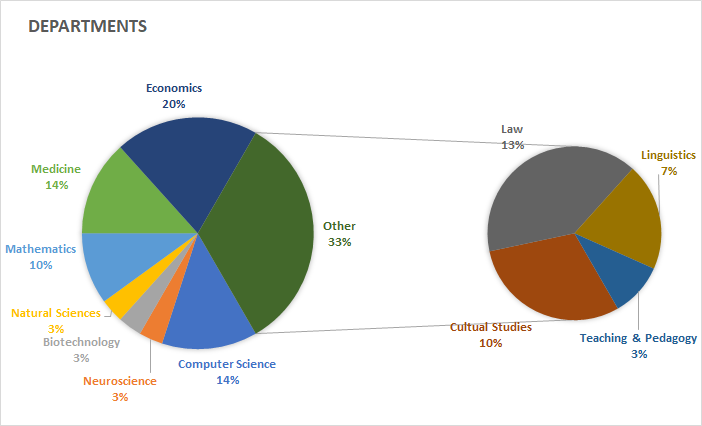
This division was reflected in those who attended the course and the numbers were fairly evenly matched between those teaching the natural sciences, medicine and IT when compared with Human Sciences. The results of the initial questionnaire can be seen in Table 1., together with the focus of each of the questions asked, where 1= strongly disagree and 5= strongly agree. The statistics show that the lecturers on this course were generally quite confident about their linguistic confidence but the areas which they considered to be somewhat problematic were: using spoken English, pronunciation and informal interactions, which are all related. It later emerged in the mentoring sessions, however, that some of the questions had not been completely understood, in particular ‘giving instructions’ which referred to issues of classroom management that were not clear to lecturers who generally favour a more traditional lecturing style of delivery. None of these results were surprising but formed a basis for later discussion.
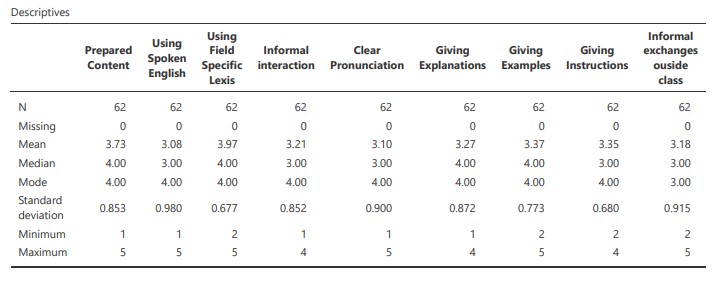
The end-of-course questionnaire, completed by 21 participants, addressed a wider range of issues, which had emerged during the course itself, and highlighted slightly different areas as can be seen in Table 2.
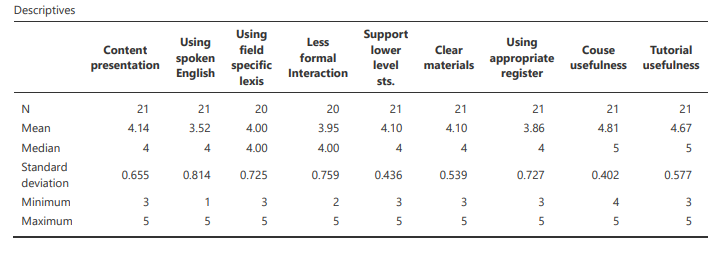
There was still more confidence in their competence when language could be rehearsed before teaching as compared to spoken, less formal language production. An awareness of register, however, emerged during the course and lecturers showed concern for the support required by learners on EMI courses for the reasons already discussed above.
This led, in fact, to the need to focus more on their methodology both in class but also online as most lecturers use blended delivery formats and are aware that the format is particularly useful for those studying in an L2 enabling learners to interact with the content and with discussions at the times they choose and with a suitable pace for each individual. This is particularly important because of the wide range of language levels in such student groups. Verona University generally establishes the entry level to English taught, post-graduate courses at the intermediate B1 level. This perhaps surprisingly low level was chosen to foster internationalization and attract greater numbers of students and the lecturers were very much aware of the need to provide support for those who struggled to keep up with the pace in the f2f context. Learning how to support L2 study also emerged very clearly in the mentoring sessions where a key area discussed and identified as a focus for many lecturers was linked to pedagogy and how lecturers could use pedagogical tools and strategies as well as adapting existing didactic materials both to aid their teaching and to support learning.
The particular tools that were experimented with during the course were classroom interactions such as pair or group work, which are innovative for many in our context but, when presented as an opportunity to co-construct knowledge and skills rather than as ‘language practice opportunities’, proved popular, since the lecturers themselves were experiencing the benefits of working in small groups during the course. The necessity of providing clear instructions, that were not too complex, but broken down into smaller parts or by demonstrating what was required, was another area of interest for these lecturers, but by far the most popular pedagogical tools were the technological ones that could be integrated into the classroom as well as into the online context such as Mentimeter, Quizlet and effective PowerPoint presentations. The question of adapting materials both for classroom and online use was also key. This will be examined in greater detail in the Implications section below.
Mentoring sessions
In the mentoring sessions what was of particular interest were mentee strengths and weaknesses and the initial concerns regarding the English use in class of the 16 mentees participating in the project. The key issues resulting from each session guided mentors in their approach and helped set the basis for further discussion. This data was then processed and coded into key concepts mentioned by the lecturers and the three graphs below illustrate the frequency with which certain topics occurred. Over the course of the sessions language related concerns shifted towards more methodological aspects.
The bar charts presented in this section display the main areas of concern lecturers expressed when describing their own language skills, as well as their focus and goals for their current and future lectures. The major concerns results (fig 2) give us an overview but the detail in the areas such as focus and goals (fig 3) is also very interesting.
The bar chart below (fig. 2) displays frequency codes over a minimum of 2 cases (where each mentee is one single case) presenting an outline of the key areas of interest to the mentees. As can be seen, pronunciation was a key concern for seven mentees followed by general language competence and adapting materials for L2 learners for six mentees and then use of language in informal contexts and comprehension. Spontaneous language production and lesson content scored lower but were still areas that reflected lecturers’ concerns.
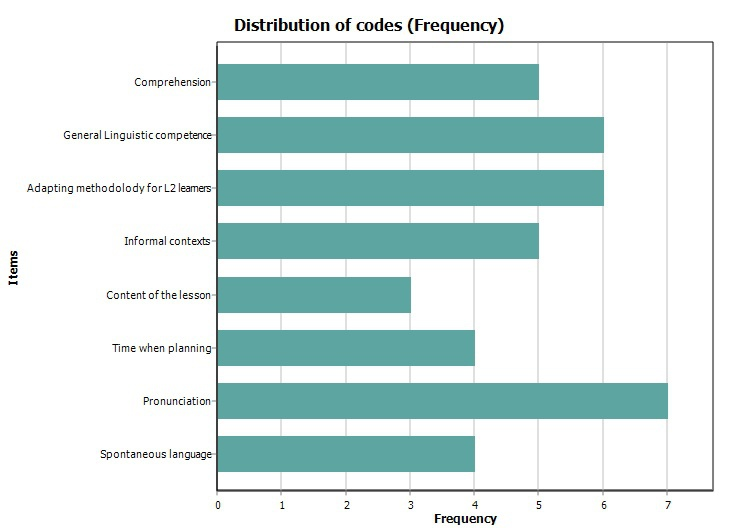
Despite their knowledge of the subject being taught, lecturers felt that incorrect pronunciation and less than complete confidence with the language seemed to be hindering content delivery for their target audience (L2 learners) and interfering with the overall learning experience. Many mentees also considered comprehension and conversation in more informal contexts and using spontaneous language to be problematic too, especially when interacting with international or visiting students, whether their interlocutors were native or non-native speakers of English.
Data collected in this stage of the study shows how lecturer objectives gradually shifted from linguistic competence to methodology and the participants became more involved in implementing new teaching strategies, such as creating PowerPoint slides effectively.
They had hitherto used PowerPoint slides, in fact, mainly to deliver text or as a written study aid for students to access and read at a later stage. They were also interested in developing online quiz activities to support learning both in class and for the virtual learning environment (VLE), in this case Moodle, for autonomous learner access. Another digital tool which sparked lecturer interest was Mentimeter, which can be used particularly effectively in large classes to encourage learner participation in lessons, transforming them from traditional lectures into a dialogic format, which is often difficult to achieve with such classes. This is done in the f2f context by students using their own devices to brainstorm ideas, ask and answer questions, which are simultaneously displayed on the classroom screen for all to see. Mentimeter, in this way, both fosters interaction and serves as a formative assessment tool as the lecturers have immediate feedback on comprehension of the content delivered.
Materials presented during the course were done so as the direct result of addressing concerns expressed in the mentoring sessions and a thorough analysis of the most common technological tools such as Mentimeter contributed to channelling their focus into classroom and online pedagogical strategies aimed at supporting the student working in an L2 The focus frequency chart below (fig 3 ) illustrates key focuses after attending the course, showing clearly that they were interested in introducing technological tools, platforms for setting up practice and discussion spaces as well as areas for making materials available for independent study into their blended teaching repertoire.
The preference for Mentimeter and PowerPoint is evident here, showing how lecturers gradually put their initial concerns aside to work on strategies that could boost class participation and help them deliver more effective lectures.
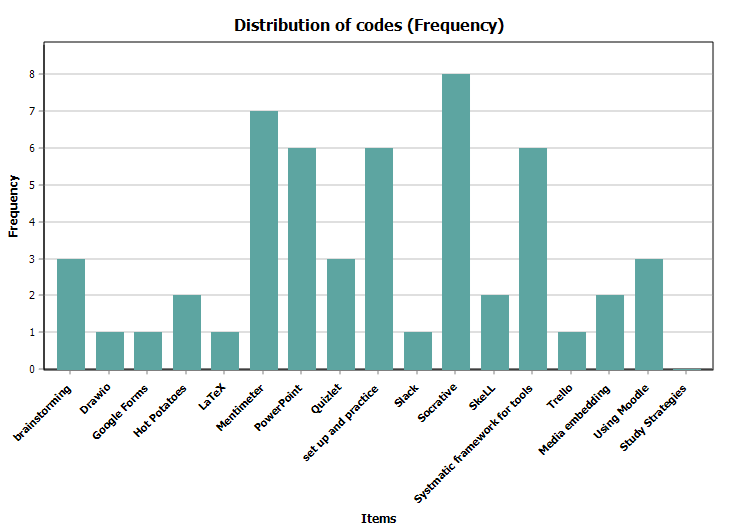
Supporting L2 study: classroom management and digital tools
As a result of this study it became clear that whilst these lecturers were still concerned with their own language competence the main focus of future courses would be related to the use of methodologies to support L2 study in HE. This involves, on the one hand, planning for and managing large groups with varying language competence so that classroom management techniques such as providing clear instructions and advice and checking comprehension and, on the other, developing an awareness of and skill in the use of pedagogical tools to achieve such aims. Lecturers at Verona University are encouraged to adopt a BL approach by means of both f2f classes and online support provided on Moodle e-learning spaces, which accounts to some extent for the popularity of the digital tools introduced during the course. The introduction of how to organize content, however, which is used in both the f2f and the online contexts was new to them and helped them to design content for a systematic learning framework.
The notion of group work was popular with many as was the gradual recognition of the importance of providing clear instructions in class and scaffolded materials for independent study such as skeleton notes to be completed on PowerPoint slides.
Mentimeter enables lecturers to brainstorm ideas in large groups, as described above. The answers provided to questions or ideas contributed in this way give extremely useful information to educators on the effective intake of their learners whilst at the same time giving more reticent learners the opportunity to interact in large groups. This is because interacting with a digital device is often a more familiar activity for young adults attending such university courses. Discussions can easily be organised ad hoc on Mentimeter as well as a range of other activities.
Socrative also proved to be popular because it can be used interactively to conduct more classic quiz activities such as multiple choice or true or false questions. Lecturers immediately saw the advantage of being able to pre-test students in this way or of providing progress tests during the course.
Padlet was another tool which proved popular as learners can create content in a range of ways, comment on each other’s ideas asynchronously, rather than synchronously in class, which is the case with Mentimeter. Padlet, although it was not perhaps as popular as other tools, also enables audio files to be recorded so that students can speak as well as write. Quizlet, which provides a range of activities with digital flashcards, is another tool which was popular with some lecturers, particularly in subjects such as anatomy or geography where it was perceived to be a useful aid for memory work.
What was also important, however, was to explore ways to make complex subjects more digestible to those studying in an L2 and the online context provided such a space, where lecturers could provide extra activities to support learning. This can be done by means of adapting traditional materials such as PowerPoint slides and the lessons learned from the world of ELT, where the wealth of research has been carried out into teaching and learning in an L2 is extremely valuable. Such techniques as setting prediction questions before reading or listening and then checking comprehension afterwards, for instance, which are common practice in ELT, were innovative in this context. An awareness of the need to grade one’s language when giving instructions or checking comprehension in general was also a new area for many of the lecturers.
The table below outlines the most popular tools from our course showing which classroom interaction they can be used for, and what specific skills they can be used to develop.
Table 3. Key methodological tools and interactions for blended EMI
|
Context |
Tool or Interaction |
Skills |
|
Classroom management for f2f contexts |
group/pair work Clear instructions Changes in pace: Short lecture + discussion Clear visual aids (not only to be used as reference notes for lecturers) |
Discussion and development of critical thinking as well as developing confidence and providing peer support |
|
Technological tools for f2f and online use (1) |
Mentimeter (in large class formats for brainstorming, polls, short comments) Padlet (in large classes for longer comments both written and oral and for peer assignments) |
This tool facilitates interaction, monitoring of intake and further discussion or remedial work. Padlet enables assignments to be set and monitored by peer comment as well as by lecturers. Material can be accessed on pcs and on mobile devices. |
|
Technological tools for f2f and online use (2) |
Quizlet (focuses on memory, and can be used for content reviews) |
Flashcards can be created by lecturers and learners and made available online for all learners. Review tests can be generated individually by learners at their own pace and games are included that can be accessed on PCs and on mobile devices. |
|
Adaptation of materials for f2f and online use |
PowerPoint Skeleton slides to be completed in a study phase. Initial prediction questions, comprehension and discussion questions to be provided with skills work (reading, listening but also lectures) |
Materials adapted to cater for varying levels of language competence. Online resources available to help those who have lower language competence. |
|
Online content delivery to be created specifically for online use |
Content pages Discussions Revision quizzes Reflection questions Feedback |
The online context is particularly suited to formative activities such as these, content is provided, discussions can be initiated and moderated, and revision, reflection and feedback built into this work in a systematic way. |
Conclusion
This was a small-scale study which aimed mainly to provide information to help us develop an effective course for those wishing to teach EMI at Verona University. What was of great interest, however, was the shift in focus of most of the lecturers during the course from a preoccupation with their own language levels to a concern for how they could support the learning or their learners. In this respect, two main areas of interest emerged: classroom management techniques such as checking comprehension and digital tools which could be used to facilitate the interaction between lecturers and large groups. BL is an ideal delivery mode, in fact, for EMI as it enables lecturers to use digital tools both in the f2f context as well as the online one, providing valuable feedback to the lecturers and support for the learners who can return to the materials online at a later stage. The next stage in our study, however, is to see how far the lecturers are integrating these tools and techniques in their everyday contexts.
References
Airey, J. 2011. ‘Talking about teaching in English: Swedish university lecturers’ experiences of changing teaching language’. Iberica 22: 35-54.
Dearden, J. 2015. ‘English as a medium of instruction - a growing global phenomenon’. British Council https://www.britishcouncil.org/sites/default/files/e484_emi_cover_option_3_final_web.pdf. Last accessed 16th March 2020
Dearden, J. 2016. ‘English Medium Instruction: A Growing Global Phenomenon.’ British Council
https://www.britishcouncil.org/education/ihe/knowledge-centre/english-language-higher-education/report-english-medium-instruction. Last accessed 16th March 2020
Dearden, J. and Macaro, E. 2016. ‘Higher Education teachers’ attitudes towards English: A three-country comparison’. Studies in Second Language Learning and Teaching 6/3: 455-86.
De Wit, H. 2016. ‘Internationalisation and the role of Online Intercultural Exchange.’ Online Cultural Exchange: Policy, Pedagogy, Practice, eds R. O’Dowd and T. Lewis, 69-82. Routledge, London.
Dornyei, Z. 2007. Research Methods in Applied Linguistics. Oxford University Press, Oxford.
Hartle, S. 2018. ‘The Quality lies in the Blend: a digital, task based approach to Professional English’. Lend – 2: 1-12.
Helm, F. 2019. ‘EMI, internationalisation, and the digital’. International Journal of Bilingual Education and Bilingualism. 23/3:314-325.
Jensen, C. & J. Thøgerson. 2011. ‘Danish University lecturers’ attitudes towards English as the medium of instruction’. Iberica 22 (autumn): 13-34.
Macaro, E., Curle, S., Pun, J., An, J., Dearden J. 2018. ‘A systematic review of English medium instruction in higher education’. Language Teaching 51/1:36-76.
Querol-Julian, M., Crawford Camiciottoli B. 2019. ‘The Impact of Online Technologies and English Medium Instruction on University Lectures in International Learning Contexts: A Systematic Review.’ ESP Today 7/1: 2-23.
Sitology
Mentimeter: https://www.mentimeter.com/ last accessed 15.04. 2020
Padlet: https://padlet.com/ last accessed 15.04. 2020
Quizlet: https://quizlet.com/ last accessed 15.04. 2020
Socrative : https://www.socrative.com/ last accessed 15.04. 2020
Please check the Pilgrims f2f courses at Pilgrims website.
Please check the Pilgrims online courses at Pilgrims website.
A Brief Practical Guide for L2 Teachers: K-2 American Children Learn Italian
Matteo Greco, ItalyThe Project Based Approach (PBA) Framework
Mija Selic, SloveniaEnglish as a Medium of Instruction (EMI): Developing Online and F2F Support Strategies at Verona University
Sharon Hartle, Italy;Geltrude Daniela Vescio, Italy;Mary Birkett, Italy;Massimo Marzio, ItalyExplicit Grammar Knowledge Development in EFL Adult Learners
William Godoy De La Rosa, Chile;Diego Monasterio, Chile